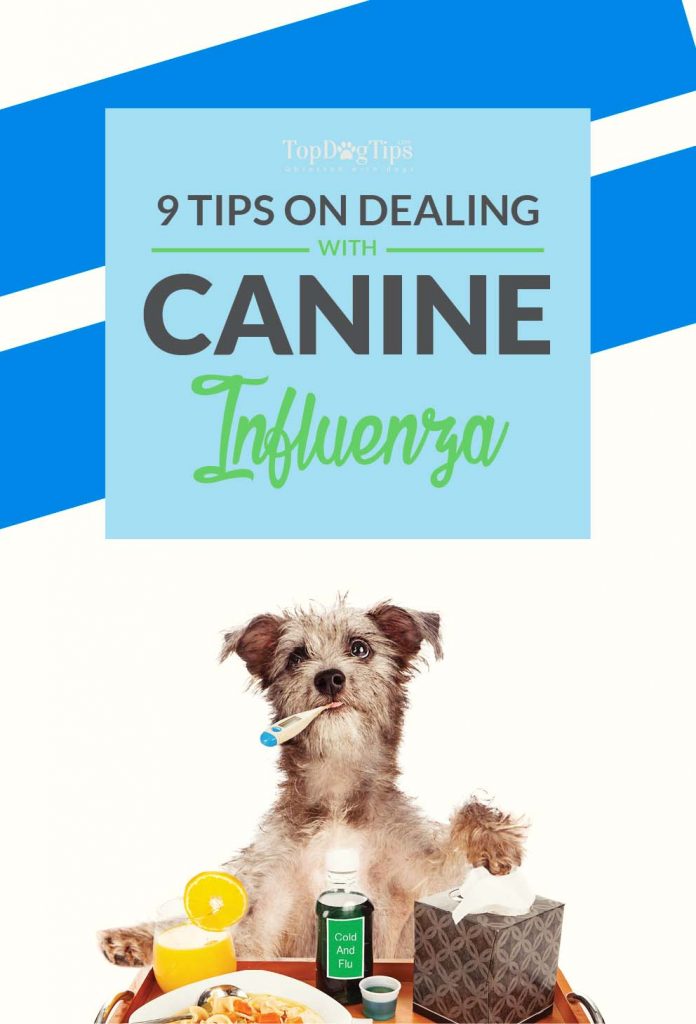
Table of Contents
The winter months are known for cold weather, the holiday season, and lots of germs! This is the time of year when everyone seems to have a cough or runny nose. It's also when the flu seems to spread as quickly as gossip.
Did you know that your canine companion is also susceptible to the flu? The truth about canine influenza is that it is much different than the strain that humans contract, and it is best that you know the facts about the disease.
Canine influenza, or dog flu, is an extremely contagious infection that is caused by an influenza A virus. The strains have been dubbed H3N8 and H3N2. H3N8 actually began as an equine influenza strain but was passed to a canine and adapted to the species. It is now a dog-specific virus.
H3N2 is the more common strain of the disease, and it seemed to be limited to Thailand, China, and Korea until March of last year. At that time, an outbreak of the disease started in Chicago and spread like wildfire in the United States. Due to the outbreak being so recent, many pet owners don't understand the disease or know what they should be looking for.
READ ALSO: 25 Most Serious Dog Health Symptoms That Cannot Be Ignored
8 Tips from Animal Experts on Canine Influenza
(Everything Pet Owners Must Know)
Much like the human flu, canine influenza is easily transferred from one dog to another. For that reason, dogs who frequent areas where other dogs gather (such as dog parks, grooming and boarding facilities, or doggy daycare facilities) are more likely to contract the disease.
Think about human influenza for a moment. If one of your coworkers had the flu, how likely is it that someone else in your workplace would contract it? More than likely, multiple people would become infected. The longer the infected person stayed in the building, the more likely it would be that germs would be spread. It works the same way for canines.
1. American Veterinary Medical Association
In this article on the American Veterinary Medical Association website, you can find all the information you'll need to know about the history of canine influenza and the transmission of the disease.
- Canine influenza is spread via aerosolized respiratory secretions (via coughing, barking, and sneezing), contaminated objects (kennel surfaces, food and water bowls, collars, and leashes), and people moving between infected and uninfected dogs. The virus can remain viable (alive and able to infect) on surfaces for up to 48 hours, on clothing for 24 hours, and on hands for 12 hours.
2. Center for Disease Control
The Center for Disease Control (CDC) also provides some great information about the dog flu. The most important thing to remember when discussing the truth about canine influenza is that influenza viruses are always adapting and changing. To date, there has never been a recorded case of canine influenza being transferred to humans, but experts are not sure that it will always stay that way.
You can learn more about the evolution of the flu virus and what the CDC is doing to protect us from it on their website.
- However, influenza viruses are constantly changing and it is possible for a virus to change so that it could infect humans and spread easily between humans. Human infections with new influenza viruses (against which the human population has little immunity) are concerning when they occur. Such viruses could present pandemic influenza threats. For this reason, CDC and its partners are monitoring the canine influenza H3N8 and H3N2 viruses (as well as other animal influenza viruses) closely.
3. Cornell University
Once you understand the background of the disease, you can begin to learn about the symptoms and the long-term effects that the disease can bring. According to this article from Cornell University, canine influenza is not typically a serious condition that you need to worry about.
The most important thing about the disease is that we need to be mindful of it so that we can control its spreading.
However, just like with the human strain of the flu, there have been a few serious cases recorded. It is wise to take your dog's infection seriously and speak with your veterinarian about a treatment plan. It's also important to monitor your pet for 10-14 days after he contracts the dog flu.
- Influenza virus infection in dogs follows a similar pattern to infections in other species. The onset of clinical signs will be 2-3 days post-infection. The peak of the virus shed is 3-4 days post-infection, and the presence of the infectious virus declines rapidly with the onset of an immune response. Dogs coughing for > 10 days are not infectious as the cough is due to damage to the respiratory tract epithelium. While in the past, CIV infections in and of themselves have not shown a significant mortality rate, CIV infections, as well as other respiratory viruses, compromise the normal defenses of the lung, permitting secondary bacterial pneumonia.
4. Cecily Jennings, DVM
This blog by Cecily Jennings, DVM, on TexVetPets.org, the symptoms of the dog flu will vary based on the severity of the strain that your dog contracts. The truth about canine influenza is that the symptoms of the mild form are very similar to the symptoms of human influenza. Your dog may experience:
- soft cough
- runny nose
- loss of appetite
- lethargy
Dr. Jennings also explains the symptoms of the severe form in her blog post.
- With the severe form, dogs will present with high fevers (103-106°F), rapid/labored breathing, significant coughing, and may start to cough up blood. Life-threatening pneumonia and respiratory complications can develop. In a small percentage of dogs, the symptoms can progress rapidly and lead to death within four to six hours of presentation to a veterinarian.
Also similar to humans, puppies, senior dogs, and dogs with a compromised immune system are more likely to contract the disease. Experts at Cornell also came up with this quick and easy fact sheet about the disease.
If you own a dog-related business, this would be a good resource to hang somewhere that pet parents can see. It's easy to read, and the simple design explains the truth about canine influenza in an easy-to-understand way. It also explains what dog owners should do in the event that their pets contract the disease.
- If your dog becomes ill, please call your vet. Many different viruses and bacteria cause symptoms similar to influenza. If your dog is ill, keep it away from other dogs. Voluntary quarantine for 5-7 days will prevent transmission of most causes of canine respiratory illness, including influenza.
5. University of Florida
If you're looking for an extensive article that includes the truth about canine influenza and everything you'll need to know about the disease, you need to check out this resource from the University of Florida. It's a one-stop-shop type of article that will answer all the questions you may have.
I think the best part of this article is the information on how the disease is diagnosed. I know when our dogs are sick, I'm always worried about the diagnosis process. Will it be quick and easy, or will it be lengthy and require numerous tests? Thankfully, diagnosing canine influenza is a quick and simple process.
- The best approach for diagnosis of canine influenza is collection of nasal swabs and serum samples. The swabs are used for the detection of viruses in dogs at the time they start coughing, and serum samples are used for the detection of CIV-specific antibodies in dogs that have been ill for more than 7 days. For dogs that have been ill for less than 4 days, veterinarians can collect nasal and pharyngeal swabs for submission to a diagnostic laboratory that offers a validated PCR test for CIV.
6. Dr. Colin Parrish, DVM
Dr. Colin Parrish from the Baker Institute for Animal Health has answered some of the most common questions about protecting your dog from canine influenza in this blog post. He explains the vaccinations available and gives some other important tips for keeping your dog safe.
- So far, there are no commercial vaccines available against the H3N2 canine influenza virus, although experimental vaccines have been described. Vaccines against the H3N8 influenza virus – which has existed in this country for more than a decade – are available, but there are differences in the genetic sequences of the two strains that suggest that these vaccines would be poorly effective or ineffective in protecting dogs against the H3N2 virus infecting dogs in the Midwest.
7. University of Tennessee
One of the best ways to protect your dog from canine influenza is to be cautious about the boarding and daycare facilities that you use. As this article from the University of Tennessee reminds us, any situation that brings dogs together increases the risk of spreading communicable diseases.
Canine influenza is not the only communicable disease that you need to be wary of. Kennel cough is another disease that spreads from one dog to another very easily. You also need to worry about parasites like fleas and worms being passed to your dog by one of their canine friends.
As the article explains, this does not mean that you should never put your dog in a daycare or boarding facility. It doesn't mean that you need to stay away from the dog park. It simply means that you need to be cautious of the other dogs that your pet is exposed to.
- Good infection control practices can reduce that risk, so dog owners involved in shows, sports, or other activities with their dogs or who board their dogs at kennels should ask whether respiratory disease has been a problem there and whether the facility has a plan for isolating dogs that develop respiratory disease and for notifying owners if their dogs have been exposed to dogs with respiratory disease. As long as good infection control practices are in place, pet owners should not be overly concerned about putting dogs in training facilities, dog parks, kennels, or other areas frequented by dogs.
8. Clemson University
The last resource that I'll leave you with this week is this article from Clemson University. It is full of excellent information for veterinarians or owners of dog-related businesses. If you own or work in a grooming salon, doggy daycare, or boarding facility, you should definitely browse through this resource.
- …caretakers can inadvertently transmit canine influenza virus from infected dogs to susceptible dogs by not following good hygiene and infection control practices. To prevent the spread of the canine influenza virus, caretakers should take the following precautions:
- Wash hands with soap and water (if soap and water are unavailable, use an alcohol-based hand cleaner)
- Before and after handling each animal
- After coming into contact with animal saliva, urine, feces or blood
- After cleaning cages
- Before eating meals, taking breaks, smoking or leaving the facility
- Before and after using the restroom
- Wear a barrier gown over your clothes and wear gloves when handling sick animals or cleaning cages. Discard gown and gloves before working with other animals…
- Wash hands with soap and water (if soap and water are unavailable, use an alcohol-based hand cleaner)














